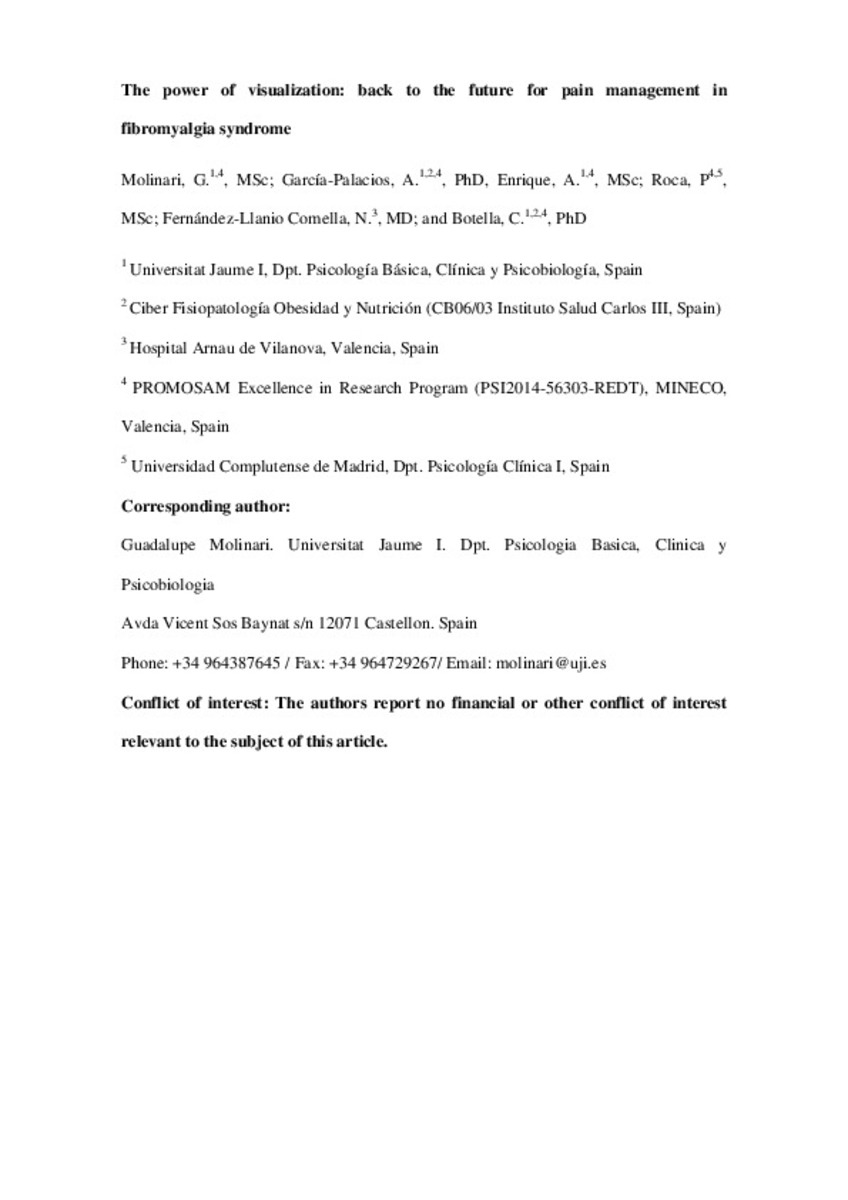Mostrar el registro sencillo del ítem
The power of visualization: back to the future for pain management in fibromyalgia syndrome
| dc.contributor.author | Molinari, Guadalupe | |
| dc.contributor.author | Díaz-García, Amanda | |
| dc.contributor.author | Enrique Roig, Angel | |
| dc.contributor.author | Roca, Pablo | |
| dc.contributor.author | Fernández-Llanio Comella, Nagore | |
| dc.contributor.author | Botella, Cristina | |
| dc.date.accessioned | 2018-10-23T09:59:27Z | |
| dc.date.available | 2018-10-23T09:59:27Z | |
| dc.date.issued | 2018 | |
| dc.identifier.citation | Guadalupe Molinari, Azucena García-Palacios, Ángel Enrique, Pablo Roca, Nagore Fernández-Llanio Comella, Cristina Botella; The Power of Visualization: Back to the Future for Pain Management in Fibromyalgia Syndrome, Pain Medicine, Volume 19, Issue 7, 1 July 2018, Pages 1451–1468, https://doi.org/10.1093/pm/pnx298 | ca_CA |
| dc.identifier.issn | 1526-2375 | |
| dc.identifier.issn | 1526-4637 | |
| dc.identifier.uri | http://hdl.handle.net/10234/176927 | |
| dc.description.abstract | Objective: Previous studies have demonstrated the effects of positive psychological factors on pain adjustment. Specifically, optimism has been linked to better physical functioning and less psychological distress. Until recently, these beneficial effects have mostly been examined in correlational studies or laboratory settings. The aim of this study is to test the efficacy of the Best Possible Self intervention using information and communication technologies with fibromyalgia patients. Methods: Seventy-one patients were randomly allocated to the Best Possible Self intervention or a Daily Activities control condition. The Best Possible Self intervention used an interactive multimedia system with the support of an Internet platform to practice the guided imagery exercise online. Results: Intent-to-treat analyses showed that, compared to the control condition, Best Possible Self patients showed significant improvements in depression, positive affect, and self-efficacy at post-intervention. Moreover, at 3-month follow-up, patients that received the intervention improved their optimism and negative affect significantly more than participants in the control condition. Discussion: This study shows how a technology-supported intervention aimed at augmenting positive affect and promoting positive functioning works in the case of fibromyalgia, expanding the intervention’s efficacy data in clinical populations and adding knowledge about the role that positive psychological factors play in pain experience. Moreover, it demonstrates the specific effects of the Best Possible Self intervention in order to incorporate this exercise in pain treatment protocols. | ca_CA |
| dc.format.extent | 44 p. | ca_CA |
| dc.format.mimetype | application/pdf | ca_CA |
| dc.language.iso | eng | ca_CA |
| dc.publisher | Oxford University Press | ca_CA |
| dc.relation.isPartOf | Pain Medicine, Volume 19, Issue 7, 1 July 2018 | ca_CA |
| dc.rights | © 2017 American Academy of Pain Medicine. All rights reserved. For permissions, please e-mail: journals.permissions@oup.com "This article has been accepted for publication in Pain Medicine, published by Oxford University Press" | ca_CA |
| dc.rights.uri | http://rightsstatements.org/vocab/InC/1.0/ | * |
| dc.subject | Fibromyalgia | ca_CA |
| dc.subject | Treatment Outcome | ca_CA |
| dc.subject | Optimism | ca_CA |
| dc.subject | Best Possible Self | ca_CA |
| dc.subject | Self-Efficacy | ca_CA |
| dc.title | The power of visualization: back to the future for pain management in fibromyalgia syndrome | ca_CA |
| dc.type | info:eu-repo/semantics/article | ca_CA |
| dc.identifier.doi | https://doi.org/10.1093/pm/pnx298 | |
| dc.relation.projectID | PSI2014-54172-R ; P11B2013-66 ; ISCII CB06 03/0052 | ca_CA |
| dc.rights.accessRights | info:eu-repo/semantics/openAccess | ca_CA |
| dc.relation.publisherVersion | https://academic.oup.com/painmedicine/article-abstract/19/7/1451/4775212?redirectedFrom=fulltext | ca_CA |
| dc.type.version | info:eu-repo/semantics/submittedVersion | ca_CA |
Ficheros en el ítem
Este ítem aparece en la(s) siguiente(s) colección(ones)
-
PSB_Articles [1303]
Articles de publicacions periòdiques







